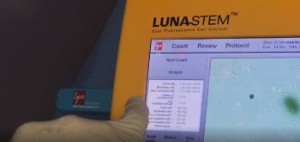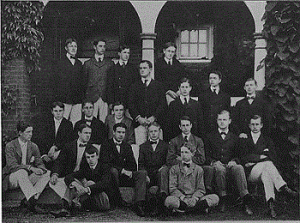The 2019 word of the year in the hair loss world has got to be “Exosomes”. Another name for exosomes is extracellular vesicles (EVs).
Update: September 2024 — Another popular option is topical exosomes for hair loss.
Update: August 2024 — A reader and his father both saw great hair regrowth from intravenous exosomes.
Update: November 2023 — Check out my comprehensive list of exosome suppliers for the hair loss market.
Update: December 2020 — I wrote an update on exosomes and hair growth, including a summary of new published studies.
Update: July 2020 — US FDA Consumer Alert on Regenerative Medicine Products. Including Stem Cells and Exosomes.
Update: December 2019 — US FDA warning on unapproved exosome products.
While exosomes can be harvested from most human stem cells, the most powerful ones are derived from mesenchymal stem cells. Exosomes contain no DNA or nucleus, and are around 1000 times smaller in size compared to regular cells.
More specifically, exosomes are tiny nanoparticles (30-100 nanometers) that are involved in cell-to-cell communication and intercellular signaling. They are secreted by most cell types in the body, and contain both messenger RNA (mRNA) and microRNA (miRNA).
Exosomes were first discovered around 35 years ago. They have only been studied extensively for the past decade. Especially in the regenerative medicine field for therapeutic applications. Exosomes are known to activate several signaling pathways that are important in wound healing, tissue regeneration and bone fracture repair. This phenomenon is called paracrine signaling.
I have had a few readers email me about exosome treatment for hair loss throughout this year. There are almost no reviews on this procedure on the internet. Initially, after minimal research, I assumed that this was just yet another platelet-rich plasma (PRP) type of treatment. See my post on whether PRP works for hair loss.
Exosomes to Grow Hair Breakthrough
However, I started paying more attention to exosomes (sometimes called micro-vesicles) a few months ago. Besides some new studies on the subject, a few renowned hair transplant surgeons emailed me to praise this fledgling technology.
Towards the end of this post, I cover some recent studies in support of using exosome injections to promote hair growth. Moreover, there is even a patent filed all the way back in 2010 and approved in 2019 from Singapore related to using exosomes for hair growth. Another patent was filed by a Turkish university in 2015, but is not yet approved.
Dr. Ron Shapiro from Minnesota told me that he is especially excited about early reports. I do not think that he is offering this treatment at his clinic as yet. However, he is very positive about its potential based on feedback from colleagues. He told me that Dr. Jerry Cooley from North Carolina is extremely knowledgeable about this subject.
Some of the early adopters are using exosomes on donor hair before and after a hair transplant and seeing thicker hair. Some are microneedling the scalp beforehand for greater absorption and effectiveness.
It has been postulated that exosome therapy promotes hair growth via providing the signals necessary to reinstate mesenchymal-epithelial communication.
Dr. Jerry Cooley
I contacted Dr. Cooley, and he told me that he is currently writing a paper on exosomes and hair growth with Dr. Daniel McGrath. Dr. Cooley thinks that Dr. McGrath has the most experience with this technology. He also thinks that “exosomes might represent a real breakthrough in hair loss treatment.”
Dr. Daniel McGrath
Dr. McGrath of McGrath Medical has injected ExoFlo into the back of his own scalp with with very good results. He also got a hair transplant for his frontal hairline five months ago. In the below video, the doctor ends with the following statement: “Stay tuned guys, because I am telling you that this is going to be something big.”
The ExoFlo exosomes are isolated from donated human bone marrow-derived mesenchymal stem cells (MSCs). Direct Biologics only launched this treatment in July 2019. The company seems very professional. It has put strict sterility and quality controls in place, including cGMP and cGTP.
ExoFloTM Exosomes and Direct Biologics
Lo an behold, yesterday, one of this blog’s readers e-mailed me a new video (embedded further below) interview with the same Dr. Daniel McGrath. This doctor is based in Austin, Texas and is using an exosome hair loss treatment called ExoFloTM.
The ExoFlo technology is manufactured by a company named Direct Biologics. The company can make over 100 million exosomes per cc in terms of concentration per one source. On Direct Biologic’s site, they describe their product as: “naturally occurring allograft extracellular vesicles.” The company purifies and processes donated human mesenchymal stem cells using a proprietary technique.
XoFloTM
Note that there is another similarly named XoFloTM treatment that utilizes mesenchymal stem cell-derived exosomes. Dr. Ken Williams is conducting a clinical trial on this technology. The exosomes in this case are derived from placental mesenchymal stem cells rather than bone marrow.
According to Bioinformant and CEO Cade Hildreth, the 4 most richly funded exosome startups through 2018 were:
- Codiak Biosciences.
- Exosome Diagnostics.
- Evox Therapeutics.
- ExCoBio.
Feedback from other Hair Loss Surgeons
Dr. John Cole
Dr. John Cole has a detailed write-up about exosomes on his website. He told me last week that he would send me some more information in the near future. I decided to publish this post rather than wait longer. Dr. Cole and exosomes were covered in a video by Hairsite in August 2019.
And just last week, Dr. Cole was interviewed on The Bald Truth Show and I have embedded the video below. He makes some very interesting points about fetal exosomes derived from amniotic fluid; the various companies involved and their wide ranging claims (he praises Direct Biologics); comparisons versus PRP, ADSC and SVF; and much more.
Despite some cautious words and warnings, Dr. Cole says that this new treatment is “about as good as it gets.” Exosomes represent the purest form of cellular therapy that is currently available. Also see past blog posts of mine where I discussed Dr. Cole’s work. In a more recent video from 2020, Dr. Cole mentioned 500 billion exosomes per 5 cc vial or injection as the latest achievement. The product is dilated with another 5 cc saline solution.
Dr. Joseph Greco

Dr. Joseph Greco is one of the pioneers in PRP and CRP technology for hair growth. I have covered him a few times on this blog in the past. He seems to always be involved in any new injection based treatments involving stem cells, cytokines, growth factors and so forth. He has an informative page on exosomes on his website. In an email to me last week, Dr. Greco said the following:
“I’m quite optimistic with the addition of exosomes for hair and with other pain and ortho treatments. Because no one really know’s proper dosing yet and how often treatments are needed, we are doing an outcome study prior to an IRB comparing exosomes verses Wharton’s Jelly UCT. I am injecting exosomes and my colleague Dr Edwin Griffin in the other arm of the study is doing the Wharton’s Jelly. Protocols include blood test before and after, global and digital photos with tattoo, patient observation forms and attached is a video of how we doing a cellular assay as part of the study. (the video can be shared). Results will be in 6 to 9 months.”
Note: Dr. Greco sent me the 3 month before and after patient photo, but he does not want it shared on this blog as yet. There is clear hair growth in that photo. The patient had a depleted donor supply from FUT and FUE done somewhere else. If Dr. Greco shares the photo in future, I will paste it here.
Dr. Chiara Insalaco
Dr. Chiara Insalaco is based in Italy and has in the past worked closely with Dr. Cole. She has been involved in some truly ground breaking work in hair loss. However, in the case of exosomes, Dr. Insalaco was cautious and told me the following:
“Actually the research is still in progress. We don’t have yet any scientific evidence about it. I will come back to you when we will have more information.”
Others
- A California-based company named Novus has been promoting exosomes for hair loss prevention very heavily recently. Their website even claims that:
Hair loss will soon be an affliction of the past. Exosomal therapy is the hair restoration treatment of the future.
I hope that this is not just marketing, and that they have seen strong proof with their own eyes.
- Also getting into the action is Avalon GloboCare, whose CEO Dr. David Jin seems very optimistic.
- Update: ExoCoBio (South Korea) is yet another new company involved in using exosomes for hair loss. Their main focus seems to skin regeneration, and they are targeting both cosmetic and medical applications. In April 2020, company CEO Byong Cho made an interesting webinar presentation. He discusses exosomes and hair loss in the second half of the video. On Facebook, the company announced in January 2020 the pending release of a 10 billion exosomes per cc hair loss product.
Recent Studies on Exosomes and Hair Growth
Note that there already exist a few studies that have concluded positive effects on hair growth after exosome treatment.
- A 2017 study on the use of extracellular vesicles derived from MSCs concluded conversion of hair from telogen to anagen.
- A 2018 study from China found exosomes to regulate hair follicle development and growth.
- A 2019 summary from Spain covered the role of extracellular vesicles in hair follicle dynamics and skin remodeling.
- A 2019 study from South Korea found exosomes to benefit human hair growth. These exosomes were derived from human dermal papilla cells. They promoted hair growth in cultured human hair follicles. Moreover, they also strengthened the hair-inductive capacity of cultured dermal papilla spheres.
- A 2019 study from France found extracellular vesicles able to stimulate hair follicle growth via Norrin secretion from the dermal papilla. The researchers in that paper seem to be associated with SILAB and their Hairgenyl trademarked product.
- Another 2019 study from South Korea found favorable results in 20 patients.
- A 2020 summary from China of stem cell-derived exosomes and conditioned medium (CM) for hair growth.
- A 2020 finding that dermal exosomes promote hair regeneration by regulating β-catenin signaling.
- A 2020 literature review with before and after photos.
Also of interest, several years ago, I covered a new hair loss drug candidate called UK 5099. Earlier this year, scientists successfully tested a combination treatment involving this UK 5099 drug and exosomes in growing hair. The delivered both products via a unique microneedle patch.
Further reading: A 2011 article titled “Exosome Explosion” suggests that this field only started getting significant traction around that year. And when it comes to hair loss, it seems like we are only starting to get traction in 2019. One amazing thing of note — in 2005, there were less than 50 results on PubMed for a search on “exosomes”. Today, there are over 10,000 results.
Growth Factors in Extracellular Vesicles
There are 100s of proteins, cytokines and growth factors in exosomes. Far more than found in platelet-rich plasma. Among the ones that are proven to aid hair growth and have been covered on this blog in the past include FGF, HGF, IGF and VEGF.
Make sure to read my post on PRP and growth factors for more information on how growth factors benefit scalp hair.

